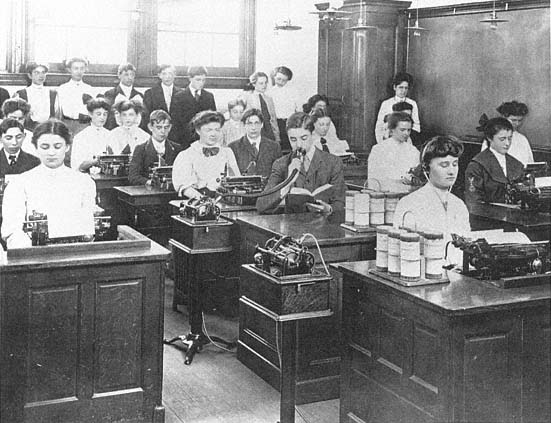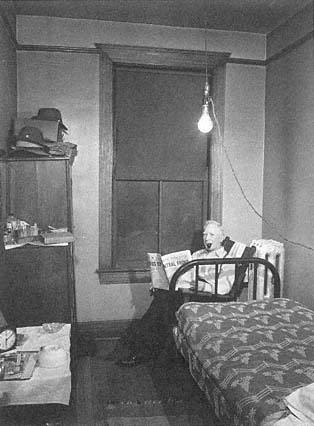Economic Limbo
Like Dorothy Richardson, the vast majority of single-room residents in turn-of-the-century rooming houses were young men and women recently arrived in the city. In 1906, the sociologist Albert Wolfe characterized the rooming house residents of Boston's South End as a "great army of clerks, salesmen, bookkeepers, shop girls, stenographers, dressmakers, milliners, barbers, restaurant-keepers, black railroad porters and stewards, policemen, nurses, . . . journeymen carpenters, painters, machinists, and electricians" (fig. 4.11).[34] In more clinical terms, Wolfe had found an army of low-paid but skilled white-collar and blue-collar workers, rarely immigrants but usually American-born of northern European and most often Protestant stock.
These city recruits struggled with their uncertain standing: they often held strong family values but were living outside a family; they were capable of being well dressed but only in one or two outfits; they aspired to material comfort but had access to very little of it; they aimed for economic security but lived with uncertain incomes. Typically, work had lured rooming house residents to the city, and it was the realities of their work that kept them in an economic and residential limbo.

Figure 4.11
Course in typing and Dictaphone, 1906, at Bryant High School, New York City. Young people
trained in these skills were often rooming house residents.
Rooming house women and men shared similar employments but had sharply differing incomes. The women's situation was the more acute. Women represented a third to a half of the people in American rooming houses.[35] In Wolfe's 1906 study, about one-sixth of the women were wives with no employment outside their homes. Single elderly women, or as Wolfe put it, "old ladies, most of them living on modest incomes, or supported by some relative or by charity," made up 8 percent of the women in his study. Stenographers, waitresses, dressmakers, saleswomen, and clerks roughly tied as the most common occupations among the working women, with 6 to 8 percent apiece.[36] The waitresses typically worked in small cafés within the rooming house district itself. The clerks worked in small shops, not in department stores where wages were too low to support even the cheapest rooming house rents. In San Francisco, women's average pay in similar jobs in 1920 was still typically too low for women to live alone in a rooming house as men did (table 3, Appendix). Thirty to 60 percent of San Francisco's working women could not afford a room alone, espe-
cially before 1920, and they doubled up with another woman to share the rent. The only lower pay rates in San Francisco were those of Chinese laborers and children.[37]
After 1920, new industrial and commercial jobs and the sudden rise of entry-level white-collar work helped more women migrate to the city and live outside a family. The U.S. Census showed an increase from 1,300 San Francisco stenographers and typists in 1900 to nearly 12,000 in 1930. In those same years, women's jobs as bookkeepers, cashiers, and accountants increased by a factor of six. The number of women working in more traditional retail clerk jobs doubled between 1900 and 1910 and again by 1920. Nationally, women were half of the total office force by 1920; clerical work made up a quarter of women's jobs and had surpassed manufacturing as the second largest employer of women.[38] These surges in women's office work were closely related to factory and wholesaling expansions. From 1890 to 1920, each two additional unskilled industrial workers added a new salaried overseer or skilled office worker.[39] These women, when they were single, increasingly looked to rooming houses for shelter.
Among the men in Wolfe's study, "clerk" and "salesmen" were the most common occupations, with 13 and 8 percent, respectively. Merchants and waiters were equal, with about 5 percent; the other significant groups were foremen, engineers, real estate and insurance workers, and cooks.[40]
Skilled workers did not figure prominently in Wolfe's study of Boston, but in many cities skilled workers were common in rooming houses (fig. 4.12). In San Francisco, for instance, a fourth of the city's carpenters in 1900 were boarders or lodgers, most of them living downtown. Students in colleges and business schools relied on rooming houses. Woodrow Wilson lived in Baltimore rooming houses in 1883 – 84 while he was a graduate student at Johns Hopkins University. After World War II, the employment of rooming house men shifted with the urban economy. In New York, people working in the merchant marine or night bus routes became as common as waiters had been before the war.[41]
For both men and women in rooming houses, frequent moves were common. Half the roomers in a city moved within a typical year, usually from one rooming house to another. Frequent moves were also part of the work life for machinists, cigar workers, and people in construction trades. Layoffs were another major factor in this rooming house

Figure 4.12
A 68-year-old railroad employee in his YMCA room in Gibson,
Indiana, 1943.
mobility. Jobs at this income level were often erratic or seasonal. Particularly in the slow summer months, roomers were forced to desert the city and live elsewhere—often with their rural families. Frequent moves were easily accomplished because roomers owned few personal possessions and could pack them into one or two bags or at most a trunk. Two rooming house women joked that the word home for them meant "a place where we can unpack our trunk, anchor our electric iron and hang our other blouse over the chair."[42]
Although the number of roomers increased from 1870 to 1950, and their employment changed, the sex and age composition of rooming house areas remained relatively constant. Ages between twenty and forty-five were far more represented than in immigrant family neighborhoods or in the suburbs. Rooming house people rarely had children living with them, although social workers' interests in children meant that reports usually overemphasized them. The elderly men and women in rooming houses, although not generally prominent before World
War II, tended to live in the older and cheaper buildings. In the late 1920s, one committee reported that lack of proper heat was "one of the great privations of the elderly" in single-room housing.[43] Landladies said that they preferred men to women as tenants because men were more easygoing and long-suffering—and out of the house more. Women were "constantly waiting to use the laundry, wash in their rooms, or do light cooking." Men could also afford higher rents. From their side, women complained that the landladies required women tenants to do their own cleaning, while for the same rents, the men did not.[44]
Nineteenth-century rooming house residents also sorted themselves by ethnic, racial, and occupational considerations. Some housekeepers preferred Catholic or Protestant tenants, or mechanics over clerks. These distinctions became less common after 1900. When blacks moved into Chicago rooming house areas, the population pyramids and age-sex formations did not change, although racial discrimination meant that crowding was far worse inside black rooming houses.[45]
Not everyone in rooming houses was single or living alone. Couples, either married or unmarried, ranged from 7 to 38 percent of the roomers. White couples often rented two-room suites. Crowded conditions in black rooming houses largely precluded more than one room. After World War II, some rooming house districts had a higher proportion of couples (again, both married and unmarried) than those neighborhoods had seen in the 1920s. The life-style remained similar to the earlier period. For women, becoming a "charity girl" (that is, living with a man without marrying him) became one way to escape the binds of low wages. Being a charity girl was at least an alternative to working in the sexual service sector: prostitution, taxi-dance work, dancing in a chorus line, gold digging (that is, consorting with men primarily for expensive gifts or lucrative divorces), or in later years, cocktail waitressing.[46] Nominally appearing to be single, homosexual couples of men or women could also live together in rooming houses. They apparently provoked little suspicion or approbation, as adult pairs of men or women commonly lived together to share expenses. Some rooming house districts were known to be areas that gay men or lesbians lived in and frequented.[47]
Rooming houses also proved useful for families with a problem relative. Families could rid themselves of offending relatives by sending
them to a distant city and supporting them with steady monthly payments as long as they stayed away. From wealthy families, such a remittance man or remittance woman could derive a comfortable life in a palace or midpriced hotel. For the vast majority, however, this situation meant a rooming house. Each remittance person had his or her reasons for being sent away; the common problems were drink, gambling, congenital brain defects, eccentricity, or being mildly crazy. "Every hotel has its crank boarders," hotel manager Ford told his peers at a convention speech in 1903. He continued with this example:
One of the good old New York hotels had a lady who stole a plate at every meal and kept them all in her room—for 30 years. She's not quite right in her mind, but she's unexceptional in regard to everything except plates.[48]
In surveys taken in the 1920s, college students complained that rooming house and residence club life forced them to associate with people who displayed personal peculiarities and maladjustment or who were "mentally or nervously upset."[49] The cheaper the hotel, the more likely would residents find this admixture to the population.
Low entry costs coupled with low and uncertain pay brought most people to the front desk of a rooming house. Unlike setting up an apartment, rooming house tenants did not have to buy linens, dishes, furniture, or cleaning equipment. In 1906, for their ready-to-live-in room, tenants paid from $1 to $7 a week (or its multiple by the month). Young Will Kortum in San Francisco found that the cheapest livable hotel rooms in the South of Market district were dark hall rooms at $2 a week or rooms with outside light for $2.50 a week. In Boston's South End, he would have found similar prices. The large rooms in an old house cost from $4.50 to $6.[50] After two decades of inflation, 1920s prices in former-house rooming houses had not gone up, while tenants in newer, purpose-built rooming houses paid from $4 to $10. The average rooming house tenants paid about the same per week for food as they did for rent.[51] Against these weekly costs, a woman salesclerk or sewing machine operator in San Francisco earned only $9 to $12 a week in 1910; unskilled confectionary workers or biscuit packers made only $6 to $9. Men operating sewing machines made $18 to $21, and other skilled men's incomes went to about $25 a week (table 4, Appendix).[52] The low prices in rooming houses kept an independent low-paid work force available to downtown industries and also helped young
single Americans forge personal independence and a subculture separate from the city's family zones. The rooming house district became notable for both of these roles.